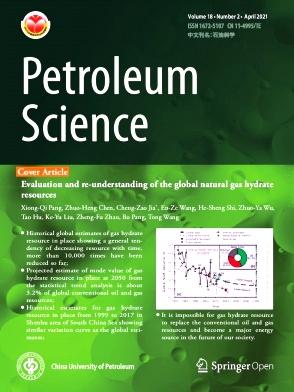页岩油藏预碳酸-二氧化碳混合压裂效果影响因素的原位实验室研究
IF 6.1
1区 工程技术
Q2 ENERGY & FUELS
引用次数: 0
摘要
超临界一氧化碳(SC-CO)压裂作为一种无水压裂技术,在页岩油藏开采领域日益受到关注。最近,有人提出了一种新型的预SC-CO混合压裂方法,它结合了SC-CO压裂和水力压裂的优点。然而,不同的预SC-CO注入条件对页岩储层的物理参数、力学性能和裂缝扩展行为的具体影响仍不清楚。在本研究中,我们采用了新开发的 "前-SC-CO 注入→水基压裂 "综合实验装置。通过原位条件下的实验,研究了预碳酸氢盐注入位移和注入量对页岩矿物成分、力学参数和裂缝扩展行为的影响。研究结果表明,预注入 SC-CO 导致粘土和碳酸盐矿物含量减少,而石英含量增加。石英含量与 SC-CO 注入量呈正相关,而与注入位移呈负相关。弹性模量和抗压强度呈下降趋势,而泊松比呈上升趋势。预注入 SC-CO 造成的页岩力学削弱与注入位移和注入量呈正相关。此外,预注入 SC-CO 可增强页岩的塑性变形行为,其击穿压力比水力压裂法低 16.6%。随着预注入 SC-CO 参数的逐渐增加,击穿压力呈非线性下降趋势。水力压裂通常沿最大主应力方向产生原生裂缝,而预碳酸氢碳混合压裂则不同,会产生更复杂的裂缝网络。随着前SC-CO注入位移的增加,沿纵轴方向会形成交叉的双Y形复杂裂缝。另一方面,随着注入速度的增加,沿非主应力方向会产生次生裂缝。本研究获得的启示对页岩油藏中预SC-CO混合压裂的设计具有重要指导意义。本文章由计算机程序翻译,如有差异,请以英文原文为准。
In-situ laboratory study on influencing factors of pre-SC-CO2 hybrid fracturing effect in shale oil reservoirs
Supercritical CO2 (SC-CO2) fracturing, being a waterless fracturing technology, has garnered increasing attention in the shale oil reservoir exploitation industry. Recently, a novel pre-SC-CO2 hybrid fracturing method has been proposed, which combines the advantages of SC-CO2 fracturing and hydraulic fracturing. However, the specific impacts of different pre–SC-CO2 injection conditions on the physical parameters, mechanical properties, and crack propagation behavior of shale reservoirs remain unclear. In this study, we utilize a newly developed “pre-SC-CO2 injection → water-based fracturing” integrated experimental device. Through experimentation under in-situ conditions, the impact of pre-SC-CO2 injection displacement and volume on the shale mineral composition, mechanical parameters, and fracture propagation behavior are investigated. The findings of the study demonstrate that the pre-injection SC-CO2 leads to a reduction in clay and carbonate mineral content, while increasing the quartz content. The correlation between quartz content and SC-CO2 injection volume is positive, while a negative correlation is observed with injection displacement. The elastic modulus and compressive strength exhibit a declining trend, while Poisson's ratio shows an increasing trend. The weakening of shale mechanics caused by pre-injection of SC-CO2 is positively correlated with the injection displacement and volume. Additionally, pre-injection of SC-CO2 enhances the plastic deformation behavior of shale, and its breakdown pressure is 16.6% lower than that of hydraulic fracturing. The breakdown pressure demonstrates a non-linear downward trend with the gradual increase of pre-SC-CO2 injection parameters. Unlike hydraulic fracturing, which typically generates primary fractures along the direction of the maximum principal stress, pre-SC-CO2 hybrid fracturing leads to a more complex fracture network. With increasing pre-SC-CO2 injection displacement, intersecting double Y-shaped complex fractures are formed along the vertical axis. On the other hand, increasing the injection rate generates secondary fractures along the direction of non-principal stress. The insights gained from this study are valuable for guiding the design of preSC-CO2 hybrid fracturing in shale oil reservoirs.
求助全文
通过发布文献求助,成功后即可免费获取论文全文。
去求助
来源期刊

Petroleum Science
地学-地球化学与地球物理
CiteScore
7.70
自引率
16.10%
发文量
311
审稿时长
63 days
期刊介绍:
Petroleum Science is the only English journal in China on petroleum science and technology that is intended for professionals engaged in petroleum science research and technical applications all over the world, as well as the managerial personnel of oil companies. It covers petroleum geology, petroleum geophysics, petroleum engineering, petrochemistry & chemical engineering, petroleum mechanics, and economic management. It aims to introduce the latest results in oil industry research in China, promote cooperation in petroleum science research between China and the rest of the world, and build a bridge for scientific communication between China and the world.
 求助内容:
求助内容: 应助结果提醒方式:
应助结果提醒方式:


